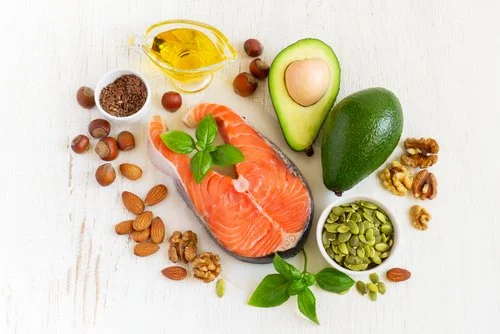Fats
We all need some amount of fat in our diets, preferably unsaturated (healthier fat), to help absorb certain vitamins and stay healthy. Eating too much fat can make us more likely to put on weight (like with any nutrient), which can increase our risk of heart disease and type 2 diabetes.
It is recommended that total fat makes up to around 30% of our daily energy intake. The intake of saturated fat should not exceed 11% (or about 30g for men and 20g for women).
There are several types of fat that can have different effects on health but gram for gram, all types of fat contain the same number of calories (1g = 9kcal). You should try to swap most of saturated fats in your diet for unsaturated fats.
Saturated fat
Mainly found in animal products e.g., meat and meat products, milk, cheese, butter and in pies, pastries, biscuits, cakes. Some plants contain high levels too – mainly coconut and palm oils. Having a high intake of saturated fat may be linked to raised levels of LDL (‘bad’) cholesterol and therefore cardiovascular disease.
Unsaturated fat
There are two kinds of unsaturated fat:
Monounsaturated – these help to protect our heart by maintaining levels of ‘good’ cholesterol and reducing levels of ‘bad cholesterol’. We can find these in avocados, olive oil, some nuts (such as almonds, peanuts, Brazil nuts) or rapeseed oil.
Polyunsaturated – can help lower the ‘bad’ cholesterol. These can be found in oily fish, linseed, walnuts, chia seeds or sunflower oil.
Trans fats
Trans fats are formed when oil goes through a process called partial hydrogenation, which makes the oil more solid and stable. This can be used for frying and in processed foods. Trans fats can increase your LDL cholesterol levels and decrease your HDL cholesterol, and they are linked to cardiovascular disease. Trans fats are being phased out, many manufacturers have now removed partially hydrogenated oil from their products and there is a voluntary agreement between brands and supermarkets that they will not use trans fats in their products.
Cholesterol
Cholesterol is mostly made in the liver from any type of fat. It is carried around the body as LDL cholesterol (‘bad’ cholesterol) or HDL cholesterol (‘good’ cholesterol). Too much bad cholesterol in the blood may cause blood vessels to become narrowed or blocked and be a risk factor for heart disease. Good cholesterol takes the bad one away from areas of the body where there is too much, to the liver to be disposed of.
The goal is to have low levels of LDL cholesterol (less than 3.0 mmol/l) and higher levels of HDL cholesterol (at least 1.0 mmol/l for men and at least 1.2 mmol/l for women). High consumption of saturated fats and other lifestyle factors (low activity levels, smoking, etc.) can increase the levels of the bad cholesterol in your blood, but it is partly down to your genetics as well – which makes it even more important to stick to the fat recommendations.
There are some products that contain something called ‘plant sterols and stanols’, those are mostly spreads, yoghurts or yoghurt drinks (e.g. Benecol). These can help lower your cholesterol if it is high. This is based on scientific evidence, so having 2-3g of plant stanols and sterols a day (one fortified yoghurt drink or yoghurt or about three teaspoons of the spread) can help lower your elevated cholesterol.
Dietary cholesterol
Although some foods contain dietary cholesterol e.g., egg yolk, shellfish or offal, this doesn’t really have an effect on blood cholesterol levels, as most of the cholesterol in our blood is made by our liver and if the dietary intake of cholesterol is high, the liver simply produces less of its own cholesterol.

